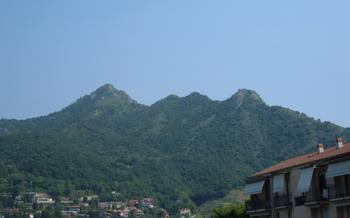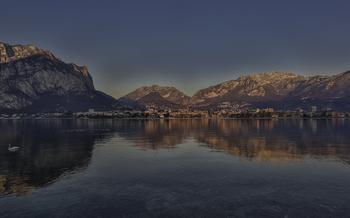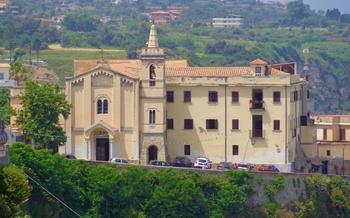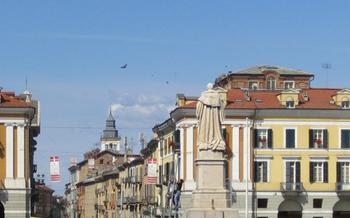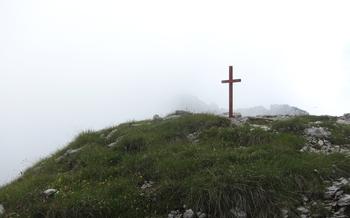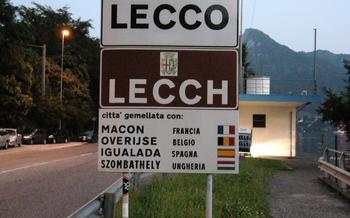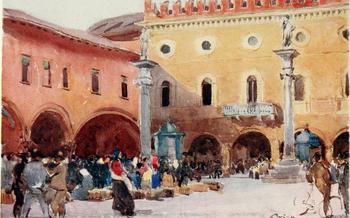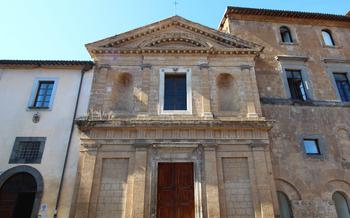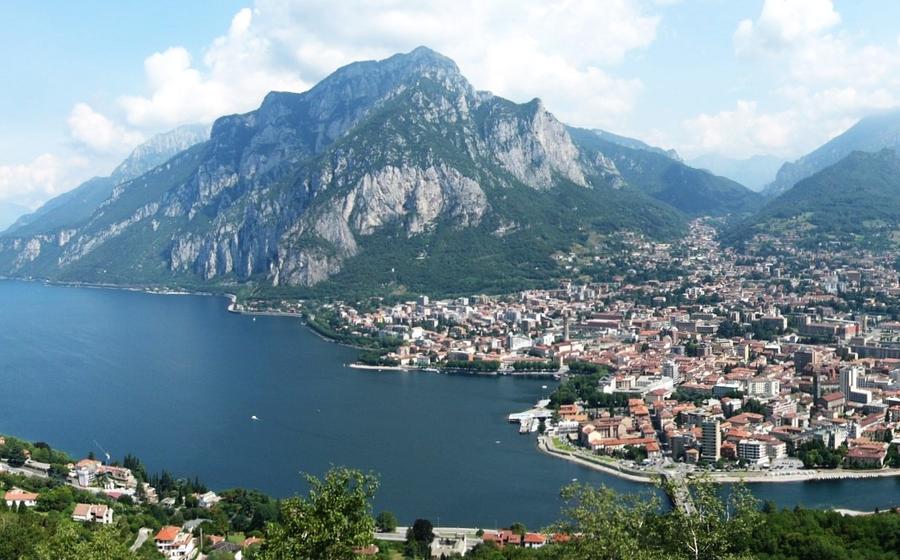
Convent of Capuchin Friars
- The Convent of Capuchin Friars: A Journey Through Time and Spirituality
- Historical Background
- Location and Getting There
- Visiting Hours and Admission
- Guided Tours
- Interior Highlights
- Crypt and Mummies
- Museum and Library
- Spiritual Significance
- Photography and Videography
- Accessibility
- Local Cuisine
- Accommodation
- Nearby Attractions
- Insider Tip: Unveiling a Hidden Sanctuary
The Convent of Capuchin Friars: A Journey Through Time and Spirituality
Nestled in the picturesque town of Lecco, Italy, the Convent of Capuchin Friars stands as a testament to the enduring legacy of the Capuchin Order and the profound spiritual heritage of the region. Its origins can be traced back to the 16th century, when a group of devoted friars sought refuge in the tranquil hills of Lecco. Over the centuries, the convent has stood as a sanctuary of worship, contemplation, and service, attracting pilgrims, art enthusiasts, and history buffs alike.
With its captivating frescoes, intricately carved woodwork, and a crypt housing remarkably preserved mummies, the convent offers a glimpse into the rich past of the Capuchin Order and the enduring faith that has shaped the identity of Lecco. Prepare to be spellbound as you delve into the history, architecture, and spiritual significance of this extraordinary convent, a place where devotion, art, and history converge.
Historical Background
The Convent of Capuchin Friars in Lecco, Italy, has a rich history dating back to the 16th century. In 1571, a group of Capuchin friars arrived in Lecco, seeking to establish a presence in the city. The Capuchin Order, founded in the early 16th century, was known for its commitment to poverty, humility, and simplicity. The friars chose a hilltop location overlooking the city, where they built a small monastery and a church dedicated to Saint Francis. Over the following centuries, the convent grew and expanded, becoming a significant religious and cultural center in the region.
The Capuchin friars played an important role in the development of Lecco. They established a school for the education of local children and provided spiritual guidance to the community. The convent also became a place of pilgrimage for those seeking spiritual enlightenment and healing. The Capuchins' devotion to charity and their commitment to helping the poor and marginalized earned them the respect and admiration of the local population.
The architectural style of the convent reflects the Capuchin Order's emphasis on simplicity and humility. The buildings are characterized by their simple lines, unadorned facades, and lack of ostentation. The church, the centerpiece of the complex, features a single nave with a barrel-vaulted ceiling. The interior is decorated with frescoes depicting scenes from the life of Saint Francis and other religious figures. The simplicity of the architecture and the serene atmosphere of the convent create a powerful sense of spirituality and contemplation.
Location and Getting There
The Convent of Capuchin Friars is strategically situated in the picturesque town of Lecco, amidst the stunning backdrop of the Italian Alps. To reach this historical gem, visitors can conveniently navigate to Via Giuseppe Ongania 17, 23900 Lecco LC, Italy. The convent's precise GPS coordinates are 4846572, 412297, allowing travelers to effortlessly pinpoint its location using GPS devices or mapping applications.
Reaching the convent is a breeze, with multiple transportation options available. For those who prefer the freedom of self-exploration, driving is an excellent choice. Ample parking spaces are available nearby, ensuring a hassle-free visit. Alternatively, public transportation offers a convenient and budget-friendly option. Several bus lines, including lines C45, C47, and C49, have stops within walking distance of the convent.
For those who enjoy the leisurely pace of a stroll, exploring the town on foot is a delightful experience. The convent is situated just a short walk from the historic center of Lecco, allowing visitors to immerse themselves in the town's charming atmosphere and admire the surrounding scenery along the way.
Visiting Hours and Admission
The Convent of Capuchin Friars in Lecco welcomes visitors during specific opening hours to ensure the preservation of its sacred spaces and the tranquility of the friars' community. Please note that these hours may vary depending on the season or special events, so it is advisable to check the official website or contact the convent directly for the most up-to-date information.
Upon arrival, visitors are kindly requested to pay a modest admission fee or make a donation to support the maintenance and restoration of the convent. This contribution is deeply appreciated and helps ensure that future generations can continue to enjoy and learn from this remarkable historical and spiritual site.
Pro Tip: To avoid any inconvenience or disappointment, it is highly recommended to plan your visit during the convent's regular opening hours and to check for any special closures or changes in advance. This will allow you to fully immerse yourself in the beauty and history of the Convent of Capuchin Friars without any unexpected surprises.
Guided Tours
Enhance your visit to the Convent of Capuchin Friars by opting for a guided tour, a valuable opportunity to delve deeper into the history, art, and significance of this sacred site. Knowledgeable guides, often members of the Capuchin Order themselves, lead these tours, providing insightful commentary and anecdotes that bring the convent's story to life.
Standard guided tours cover the main highlights of the convent, including its architecture, frescoes, mummies, museum, and library. Themed tours delve into specific aspects, such as the convent's role in the Counter-Reformation or the lives of the Capuchin friars. For a more personalized experience, private tours can be arranged for groups, allowing for tailored content and a deeper exploration of specific areas of interest.
Tour schedules vary depending on the season and availability, so it's advisable to check the convent's website or contact them directly to book a spot in advance. Fees for guided tours are typically modest, and there are often discounts for students, seniors, or families. Don't miss this chance to gain a profound understanding of the Convent of Capuchin Friars and its enduring legacy.
Interior Highlights
The interior of the Convent of Capuchin Friars is a testament to the artistic and spiritual devotion of the Capuchin Order. As visitors step inside, their eyes are immediately drawn to the remarkable frescoes and paintings that adorn the walls and ceilings. These stunning works of art, created by renowned artists of the time, depict scenes from the Bible, the lives of saints, and the history of the Capuchin Order.
Among the most notable frescoes is the depiction of the Last Supper, which graces the refectory of the convent. This masterpiece, attributed to the artist Gerolamo Romani, captures the profound moment of Jesus' final meal with his disciples. The intricate details and lifelike expressions of the figures bring the biblical narrative to life.
Another highlight of the convent's interior are the elaborate wood carvings that decorate the choir stalls and other furnishings. These exquisite works of art showcase the skill and craftsmanship of the artisans who created them. The intricate designs, featuring biblical motifs, floral patterns, and allegorical figures, add to the overall beauty and grandeur of the convent's interior.
In addition to the frescoes and wood carvings, visitors can admire the numerous sculptures, statues, and other decorative elements that adorn the convent. These works of art, ranging from delicate marble sculptures to colorful ceramic tiles, contribute to the unique aesthetic appeal of the convent, creating an environment that is both inspiring and awe-inspiring.
Crypt and Mummies
Beneath the Convent of Capuchin Friars lies a hidden world—a crypt housing the remains of Capuchin friars and local benefactors. This subterranean chamber is a testament to the unique mummification process employed by the friars, resulting in the remarkable preservation of the bodies interred within.
The mummies of Lecco, as they are known, offer a glimpse into the lives and customs of the Capuchin Order and the local community during the 17th and 18th centuries. Visitors can marvel at the intricate details of their clothing and the serene expressions etched upon their faces, as if they were merely sleeping.
The crypt is not merely a macabre spectacle but a place of contemplation and reverence. It serves as a reminder of the transient nature of life and the enduring legacy of the Capuchin Order. Visitors are invited to reflect on the lives of these individuals and their contributions to the community, gaining a deeper understanding of the historical and cultural significance of the friars and their convent.
Museum and Library
The Convent of Capuchin Friars in Lecco houses a fascinating museum that showcases a collection of artifacts, relics, and documents that shed light on the history of the Capuchin Order and the local region. Visitors can explore exhibits that delve into the daily lives of the friars, their religious practices, and their contributions to the community. The museum also displays a collection of ancient books and manuscripts in its library, which is a treasure trove for scholars and researchers. These valuable texts offer insights into the intellectual and spiritual pursuits of the Capuchins and provide a glimpse into the rich cultural heritage of the region. Special exhibitions and events are occasionally held at the museum and library, offering visitors an opportunity to engage with the convent's history and cultural significance in new and exciting ways.
Spiritual Significance
Beyond its historical and architectural significance, the Convent of Capuchin Friars in Lecco holds deep spiritual meaning for the Capuchin Order and visitors seeking spiritual guidance. The convent continues to be an active place of worship for the Capuchin friars, who reside within its walls and dedicate their lives to prayer, contemplation, and service. Visitors to the convent can witness the friars engaged in their daily rituals, creating a serene and contemplative atmosphere that invites reflection and introspection.
The convent also serves as a pilgrimage site for those seeking spiritual enlightenment and renewal. Many visitors come to the convent to pray, meditate, and seek guidance from the Capuchin friars. The friars are known for their wisdom, compassion, and willingness to share their insights with those who seek their counsel.
Throughout the year, the convent hosts various religious ceremonies and events that attract pilgrims and visitors from around the world. These events include masses, retreats, and processions that celebrate the life and teachings of Saint Francis of Assisi, the founder of the Capuchin Order. Participating in these events offers visitors a chance to immerse themselves in the spiritual traditions of the Capuchins and to experience the profound sense of community that permeates the convent.
Photography and Videography
Respect for the sacred nature of the Convent of Capuchin Friars extends to capturing moments through photography and videography. While visitors are permitted to document their visit through these mediums, it is essential to adhere to the guidelines set by the convent to maintain a peaceful and reverent atmosphere.
The use of flash photography is strictly prohibited, as the sudden burst of light can be disruptive to the tranquil ambiance of the convent. Additionally, the use of tripods or other equipment that may obstruct pathways or impede the movement of other visitors is discouraged.
Before capturing images or videos of individuals, it is imperative to seek their permission, respecting their privacy and personal space. The convent's sanctity extends beyond its physical structure, encompassing the individuals who seek solace and spiritual guidance within its walls.
By adhering to these guidelines, visitors can contribute to preserving the serenity and sanctity of the Convent of Capuchin Friars, ensuring a respectful and meaningful experience for all.
Accessibility
The Convent of Capuchin Friars is committed to ensuring that all visitors, regardless of their physical abilities, can fully experience the beauty and history of the site. Accessibility features have been carefully implemented to create an inclusive environment for everyone.
Ramps and elevators have been strategically placed throughout the convent, allowing wheelchair users and individuals with limited mobility to navigate the property with ease. Clearly marked wheelchair-accessible routes guide visitors through the different sections of the convent, ensuring a smooth and enjoyable experience.
Designated parking spaces are reserved for visitors with disabilities, located close to the main entrance for added convenience. Upon arrival, visitors can request assistance from the on-site staff, who are always ready to provide any necessary support and guidance.
The convent's commitment to accessibility extends beyond physical barriers. The staff is trained to be welcoming and accommodating to visitors with diverse needs. They are equipped to offer assistance in navigating the convent, providing information, and ensuring that everyone feels comfortable and respected during their visit.
In addition, the convent offers materials in various formats to cater to visitors with different learning styles and sensory preferences. Braille guides, audio tours, and visual aids are available upon request, allowing visitors to engage with the convent's history and exhibits in a way that is meaningful and accessible to them.
Local Cuisine
A visit to Lecco is not complete without savoring the local culinary delights. After exploring the Convent of Capuchin Friars, indulge in a traditional Italian meal at one of the nearby restaurants or trattorias. Sample the region's specialties, such as delectable lake fish dishes, creamy risotto, or hearty polenta-based meals.
For an unforgettable dining experience, try Trattoria Del Viandante, known for its authentic Italian cuisine and warm hospitality. Begin your meal with Antipasto Misto, a platter of cured meats, local cheeses, and marinated vegetables. Then, savor the Risotto con Persico, a classic Lake Como dish featuring risotto cooked to perfection with delicate lake perch.
Alternatively, visit La Griglia di Varenna, renowned for its grilled meats and panoramic views of the lake. Start with Bruschetta al Pomodoro, toasted bread topped with fresh tomatoes, basil, and olive oil. For your main course, order the Grigliata Mista, a mixed grill of succulent meats, including tenderloin, lamb chops, and sausages.
No matter your choice, remember to pair your meal with a glass of local wine, such as the crisp and refreshing Bianco di Custoza or the robust red Valtellina Superiore. End your culinary journey with a traditional Italian dessert, such as Tiramisu or Panna Cotta.
Accommodation
For a convenient and comfortable stay near the Convent of Capuchin Friars, consider the following accommodation options:
-
Albergo La Nave: This charming lakeside hotel offers stunning views of Lake Como and the surrounding mountains. Enjoy cozy rooms, a delightful restaurant, and a peaceful ambience.
-
Locanda dell'Isola Comacina: Experience a unique stay on the enchanting Isola Comacina, a small island in Lake Como. The locanda offers quaint rooms, a lakeside terrace, and a chance to immerse yourself in history.
-
La Meridiana Bed and Breakfast: For a cozy and welcoming stay, opt for this bed and breakfast situated just steps from the convent. Enjoy comfortable rooms, a hearty breakfast, and the warm hospitality of the owners.
These establishments offer a range of amenities to suit different preferences and budgets, ensuring a pleasant and memorable stay in Lecco.
Nearby Attractions
The Convent of Capuchin Friars is nestled amidst a region brimming with cultural, historical, and natural wonders. Visitors can easily extend their exploration beyond the convent walls to discover other captivating destinations in Lecco and its surroundings.
Villa Manzoni, Lecco: A short walk from the convent, discover the former residence of renowned Italian novelist Alessandro Manzoni. This 17th-century villa now serves as a museum, showcasing Manzoni's personal belongings, manuscripts, and artwork inspired by his literary masterpieces.
Monte Barro: Embark on a scenic hike or bike ride up Monte Barro, a mountain overlooking Lecco. Marvel at the breathtaking panoramic views of the city, Lake Como, and the surrounding Alpine peaks. Explore the historic remains of a Celtic settlement and the Sanctuary of Our Lady of Monte Barro, a pilgrimage site perched atop the mountain.
Lecco Town Center: Immerse yourself in the vibrant atmosphere of Lecco's historic center. Stroll along the charming cobblestone streets, lined with boutiques, cafes, and ristoranti. Visit the Basilica of San Nicolò, a 14th-century Gothic masterpiece, and admire the Renaissance frescoes adorning the Palazzo delle Paure.
Lake Como: Take a leisurely boat trip or rent a kayak to explore the picturesque shores of Lake Como, renowned for its stunning scenery and luxurious villas. Visit the enchanting villages of Bellagio, Varenna, and Tremezzo, each offering unique experiences and breathtaking views of the lake's tranquil waters.
Insider Tip: Unveiling a Hidden Sanctuary
As you explore the captivating grounds of the Convent of Capuchin Friars, take a moment to venture beyond the main courtyards and discover a hidden sanctuary that few visitors know about. Tucked away amidst the tranquil gardens lies a secluded viewpoint that offers a breathtaking panorama of the surrounding landscape.
Climb the narrow staircase leading to the rooftop terrace and prepare to be awestruck by the vista that unfolds before you. The lush greenery of the convent grounds seamlessly blends with the sparkling waters of Lake Como, creating a picturesque tapestry that stretches as far as the eye can see.
Take a deep breath and let the serene atmosphere envelop you as you soak in the beauty of this hidden gem. Capture the moment with a photograph or simply savor the tranquility, allowing the breathtaking view to leave an indelible mark on your memory.
Remember to respect the sanctity of this special place, preserving its pristine beauty for future generations to cherish. Leave no trace of your visit, and let the serenity of the hidden sanctuary remain undisturbed for all to enjoy.
